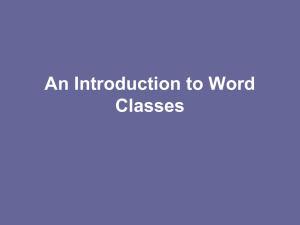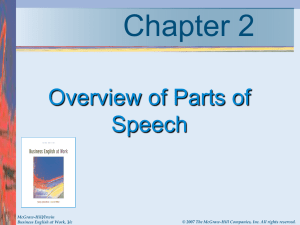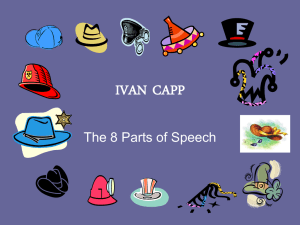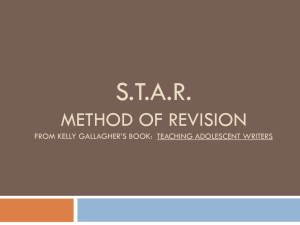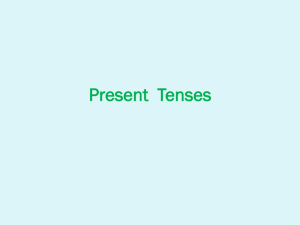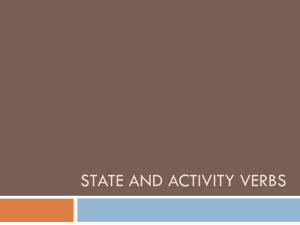GENRE THE ENGLISH TEXT TYPE
advertisement
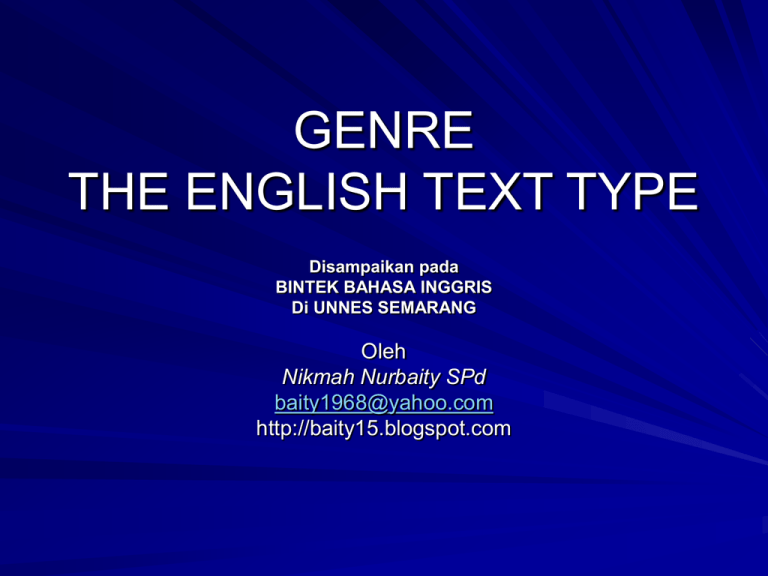
GENRE THE ENGLISH TEXT TYPE Disampaikan pada BINTEK BAHASA INGGRIS Di UNNES SEMARANG Oleh Nikmah Nurbaity SPd baity1968@yahoo.com http://baity15.blogspot.com Pembelajaran Bahasa Inggris: siswa mampu berkomunikasi lisan dan tulis dalam bahasa Inggris yang direalisasikan dalam 4 skill berbahasa: listening, speaking, reading dan writing PETA MATERI Percakapan transaksional/ interpersonal: Teks fungsional pendek Monolog / esei * linguistic features * vocabulary KELAS X SEMESTER I Percakapan Berkenalan berpisah berpisah Ajakan Tawaran Undangan Janji rasabahagia Perhatian simpati instruksi TeksFungsional P iklan pengumuman undangan Monolog RECOUNT NARRATIVE PROCEDURE KELAS X SEMESTER II Percakapan Berterimakasih Memuji Mengucapkan: selamat Terkejut Tak percaya Menerima: Undangan Tawaran ajakan Teks Fungsional P Monolog Pengumuman Iklan Undangan dll NARRATIVE DESCRIPTIVE NEWS ITEM KELAS XI SEMESTER I Percakapan Teks Fungsional Pendapat Banner Puas Poster Tidak puas pamphlet dll Menasihati Memperingatkan Meluluskan : Permintaan Menyatakan : Relief Pain pleasure Monolog REPORT NARRATIVE ANALYTICAL Eksposition KELAS XI SEMESTER II Percakapan Menyatakan: Sikap Cinta Sedih Malu Marah jengkel Teks Fungsional P Banner poster pamphlet dll Monolog NARRATIVE SPOOF HORTATORY Eksposition KELAS XII SEMESTER I Percakapan Mengusulkan Memohon Mengeluh Kemungkinan Memerintah Mengakui kesalahan Berjanji Menyalahkan Menuduh keingintahuan’ Hasrat Menyatakan : Berbagai sikap Teks fungsional banner poster pamphlet dll Monolog NARRATIVE EXPLANATION DISCUSSION KELAS XII SEMESTER II Percakapan Membujuk Mendorong semangat Mengkritik Harapan Mencegah Menyesali Menyatakan : Rencana Tujuan Maksud Memprediksi Berspekulasi menilai Teks Fungsional banner pamphlet poster dll Monolog NARRATIVE REVIEW genre Memiliki: Particular purposes ( communicative purposes ) Particular stages, distinctive : beginning, middles, and ends ( generic srtucture ) Particular linguistic features 1. RECOUNT Social function : To retell events for the purposes of informing or entertaining Generic structure : Orientation : provides the setting and introduces participants ( giving information about what, who, where and when) event : to tell what happened in what sequence RE Orientation : optional , closure of events Language features of RECOUNT Focus on spesific participant ( nouns and pronouns: we, David, the animal dll ) Material process ( Action verbs: go, sleep, run etc ) Past tense Temporal sequence ( after, before , then ) Conjuction ( but , and, …) Circumstances of time and place ( adverb / adverb phrases showing time and place ) * Adjectives to modify nouns 2. NARRATIVE SOCIAL FUNGTION To amuse, entertain, and to deal with actual or vicarious experience in different ways ( It deals with problematic events which lead to a crisis or turning point of some kind which in turn finds a resolution) Generic sructure: Orientation :sets the scene, introduces participant Evaluation : a stepping back to evaluate the plight Complication : a crisis arises Resolution : the crisis is resolved , for better or worse Re orientation : optional Language features of narrrative Specific and individualized participant ( nouns or pronouns) Material process Behavioral process ( breathe, snore, dream…) Verbal process ( said, told, asked …) Mental process ( think, understand, like….) Relational process ( time connectives and temporal conjungtion ) Temporal circumstance Past tense 3. Procedure Social function : To describe how something is accomplished through a sequence of actions or steps Generic structure Goal Material (not required for all procedure teks) Steps 1 – n ( goal followed by a series of steps oriented to achieving the goal ) Language features of procedure Generalized human agents Simple present often imperative material process ( Action verbs ) Temporal conjunction or numbering to indicate sequence Adverbs to show the detail of time and place e. g for five minutes, two centimetes from the top… 4. Description Social function To describe a particular person, place or thing Generic structure Identification , identify phenomenon to be described Description : describe or giving information about specific participant eg : comes from…, the colour, the size, the favourite things etc Language features of description Specific participant ( nouns ) Simple present Attributive and identifying Process ( relating verbs which informs about the subject) Various adjectives like : describing, numbering, classifying , two white fangs, two strong legs etc Detailed noun phrase to inform about the subject 5. News items Social function: To inform readers , listeners or viewers about events of the day which are consedered newsworthy or important Generic stucture : Newsworthy event(s) : recount the events in summary form Background events : elaborate what happenend to whom, in what circumstancec Sources : comment by participants in, witnesses to and aythorities expert on the events Language features of news item Short telegraphic information about story captured in headline Focus on person,animal, certain thing Focus on circumstance Material process ( action verbs ) Verbal process in sources stages Past tense Arranged in sequence of events 6 .REPORT Social function : to describe the way things are with reference to arange of natural , man made and social phenomena in our environment it is the result of systematic observation or analysis it is general conclusion, general statement about Generic structure: Generic classification: tell what phenomena under discussion is Description : tells the phenomena is like in the terms of *parts and their function *Qualities *Habits or behaviours Language features of report General nouns : reptiles in Comodo island Relating verbs / relational process ( is , are, …) Action verbs ( birds fly, they eat…) Present tense Technical terms ( water contain hydrogen and oxygen ..) Paragraph with topic sentence to arrange some information 7. ANALYTICAL EXPOSITION Social function : To persuade the reader or listener that something is the case that there is a case to concern, to pay attention to ) Generic stucture: Thesis Position : introduces topic and indicates writers position Preview :outlines the main arguments to be presented Arguments Points : restates main arguments outlined in preview Elaboration : develops and supports each point / argument Language features of analytical exposition General nouns : cars , pollution, handphone Abstract nouns :pilocy, government… Technical terms :species of animal… Relating verbs Action verbs Thingking verbs Modal verbs Connectivers Evaluative words : important, valuable… 8 HORTATORY EXPOSITION Social function: To persuade the reader that something should or should not be the case It exhort someone to take or to desist in some action Generic structure: Thesis : announcement of issue of concern Arguments : reasons for concern, leading to recommendation Recommendation : statement of what ought not to happen Language features of hortatory exposition Generic human and non human participant Mental process : to state what the writers thinks or feels about the issue Material process to state what happens Relational process to state what it should be Simple present Abstract nouns Technical verbs Passive form Modal verbs Evaluative words 9. SPOOF Social function : To retell an event with humorous twist Generic structure: Orientation : sets the scene Events : tell what happened Twist : provides the punchline Language features of spoof Focus on person, animal, certain thing Action verb Past tense Circumstance of time and place Material process 10.Explanation Social function: To give an account of how something works or reasons for some phenomenon ( why is it so? How does it work?) Two basic types : Explaining how : mechanical explanation ( how does a pump work?) Technological explanation ( how does a computer work? ) System explanation ( How does a company work? ) Natural explanation ( how are mountains formed? ) Explaining why : Why does things float and other sink? Why does iron go rusty? Generic structure : General statement A sequenced explanation of why or how something occurs Language features of explanation General and abstract noun Action verbs Simple present tense Passive form conjunction of time cause and effect relationships Noun phrase Abstract nouns Adverbial phrases Complex sentences Technical terms 11. Discussion Social function To present ( at least ) two points of view about an issue To look at an issue from a range of perspectives before making judgement or recommendation Generic structure : Issue : statement and preview Argument for and against or statements of differnet point of view : point and elaboration Conclusion or recommendations Language features of discussion Generic human and non human participants Material processes Relational processes Mental processes : feel , believe, think … Comparative : contrastive Consequential conjunction Reasoning expresses as verbs and nouns 12. Review Social function : To critique an art work or event for a public audience ( works of art include movies, TV shows, books, plays, operas, recordings, exhibition, concert and ballets ) Generic structure : Orientation : places the work in its general and particular context. Often by comparing it with its kind or through analogue with a non art object or events Interpretative Recount : summaries the plot and / or provides an account of how the work came into being Evaluation : usually recursive ( evaluation 1,2,3,… ) Evaluative summation Language features of review Focus on particular participant Attitudinal lexis to show Direct expression of opinion, including attitudinal epithets in nominal groups Qualitative attributive and affective mental processes Elaborating and extending clauses Metaphorical language The next??? Important terms to master material process? epithet? circumstance??? etc … lets discuss together

